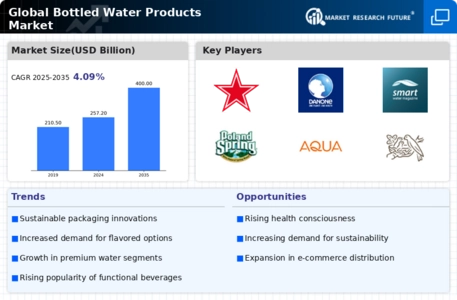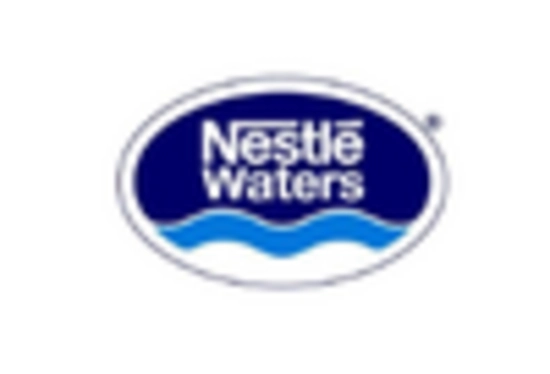Health Consciousness
The increasing awareness of health and wellness among consumers appears to be a primary driver for the Bottled Water Products Market. As individuals prioritize hydration and seek healthier alternatives to sugary beverages, bottled water has gained traction. According to recent data, bottled water consumption has surged, with a notable increase of approximately 6% annually. This trend suggests that consumers are gravitating towards products that promote well-being, thereby enhancing the market's growth potential. Furthermore, the rise of fitness culture and the emphasis on maintaining a balanced lifestyle contribute to the demand for bottled water, as it is perceived as a convenient and healthy option. Consequently, the Bottled Water Products Market is likely to continue expanding as health-conscious consumers increasingly opt for bottled water over other drink options.
Diverse Product Offerings
The Bottled Water Products Market is experiencing a notable expansion in product diversity, which serves as a key driver of growth. Consumers are increasingly seeking variety, leading to the introduction of flavored, mineral-infused, and functional waters. This diversification caters to different taste preferences and health needs, thereby attracting a broader audience. Recent data suggests that flavored bottled water has seen a growth rate of approximately 8%, indicating a shift in consumer preferences towards more innovative options. As brands continue to experiment with new flavors and formulations, the Bottled Water Products Market is likely to benefit from heightened consumer interest and engagement. This trend not only enhances market competitiveness but also encourages brands to differentiate themselves through unique product offerings.
Environmental Sustainability
Sustainability initiatives are becoming increasingly pivotal in shaping consumer preferences within the Bottled Water Products Market. As environmental concerns rise, consumers are more inclined to support brands that demonstrate a commitment to eco-friendly practices. This shift is evidenced by the growing demand for bottled water packaged in recyclable materials and the introduction of biodegradable bottles. Recent statistics indicate that nearly 50% of consumers are willing to pay a premium for sustainable products, which underscores the potential for growth in this segment. Companies that adopt sustainable practices not only enhance their brand image but also align with the values of environmentally conscious consumers. Thus, the Bottled Water Products Market is likely to witness a transformation as brands innovate to meet the expectations of a more eco-aware customer base.
Convenience and Accessibility
The convenience factor associated with bottled water is a significant driver for the Bottled Water Products Market. In an increasingly fast-paced world, consumers seek products that offer ease of use and accessibility. Bottled water provides a portable hydration solution that fits seamlessly into busy lifestyles. Recent market analysis indicates that convenience stores and vending machines are among the top distribution channels for bottled water, accounting for a substantial share of sales. This trend suggests that as urbanization continues to rise, the demand for easily accessible bottled water will likely increase. Additionally, the proliferation of on-the-go consumption patterns further supports the growth of the Bottled Water Products Market, as consumers prioritize products that can be consumed anytime and anywhere.
Marketing and Branding Strategies
Effective marketing and branding strategies are crucial drivers for the Bottled Water Products Market. As competition intensifies, brands are increasingly focusing on creating strong identities and engaging narratives to capture consumer attention. Innovative advertising campaigns and social media presence play a vital role in shaping consumer perceptions and preferences. Recent studies indicate that brands with robust marketing strategies experience higher customer loyalty and retention rates. This suggests that as companies invest in brand development and consumer engagement, they are likely to see a positive impact on sales and market share. Furthermore, the Bottled Water Products Market may witness a shift towards experiential marketing, where brands create memorable experiences that resonate with consumers, thereby fostering deeper connections and driving growth.


















Leave a Comment